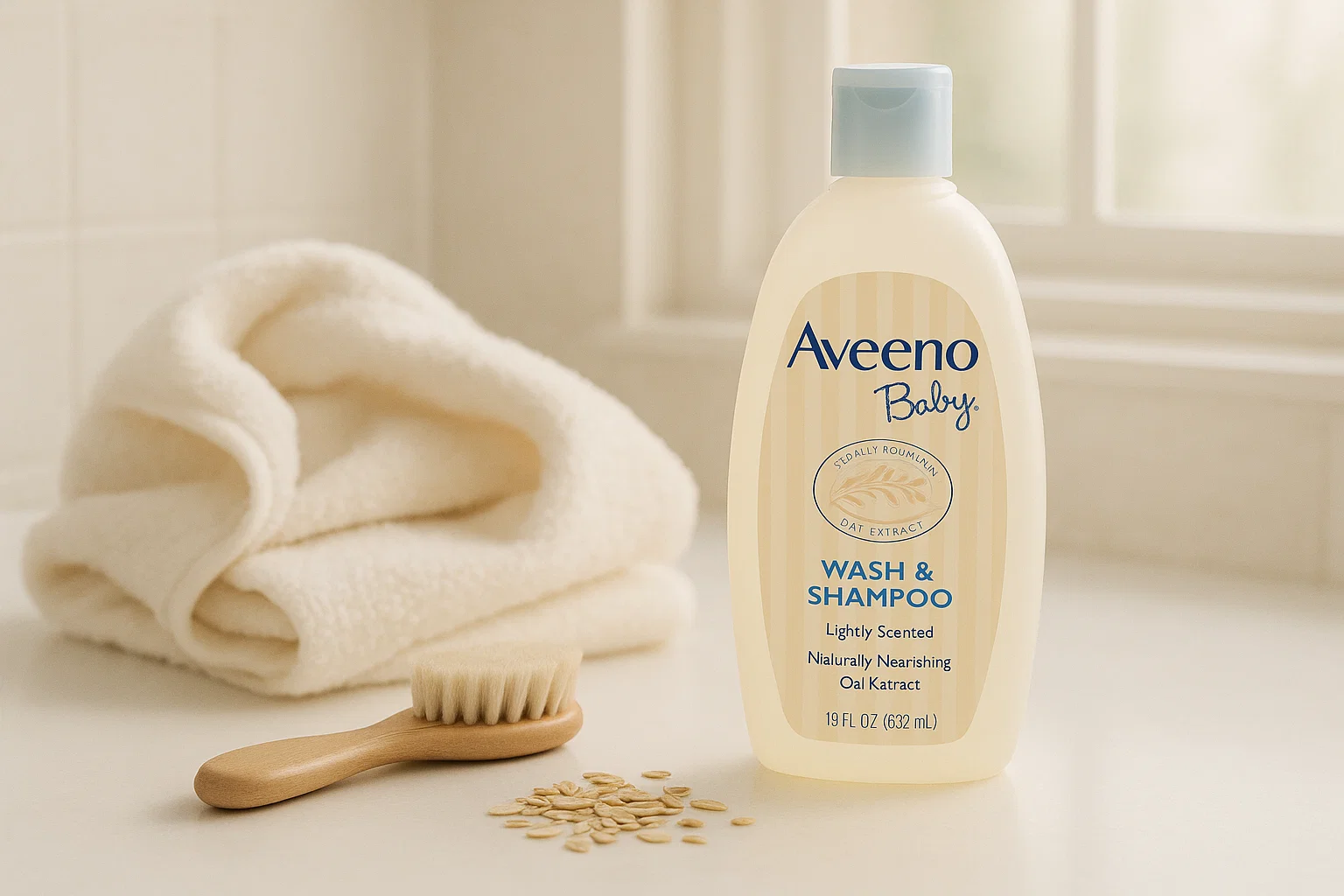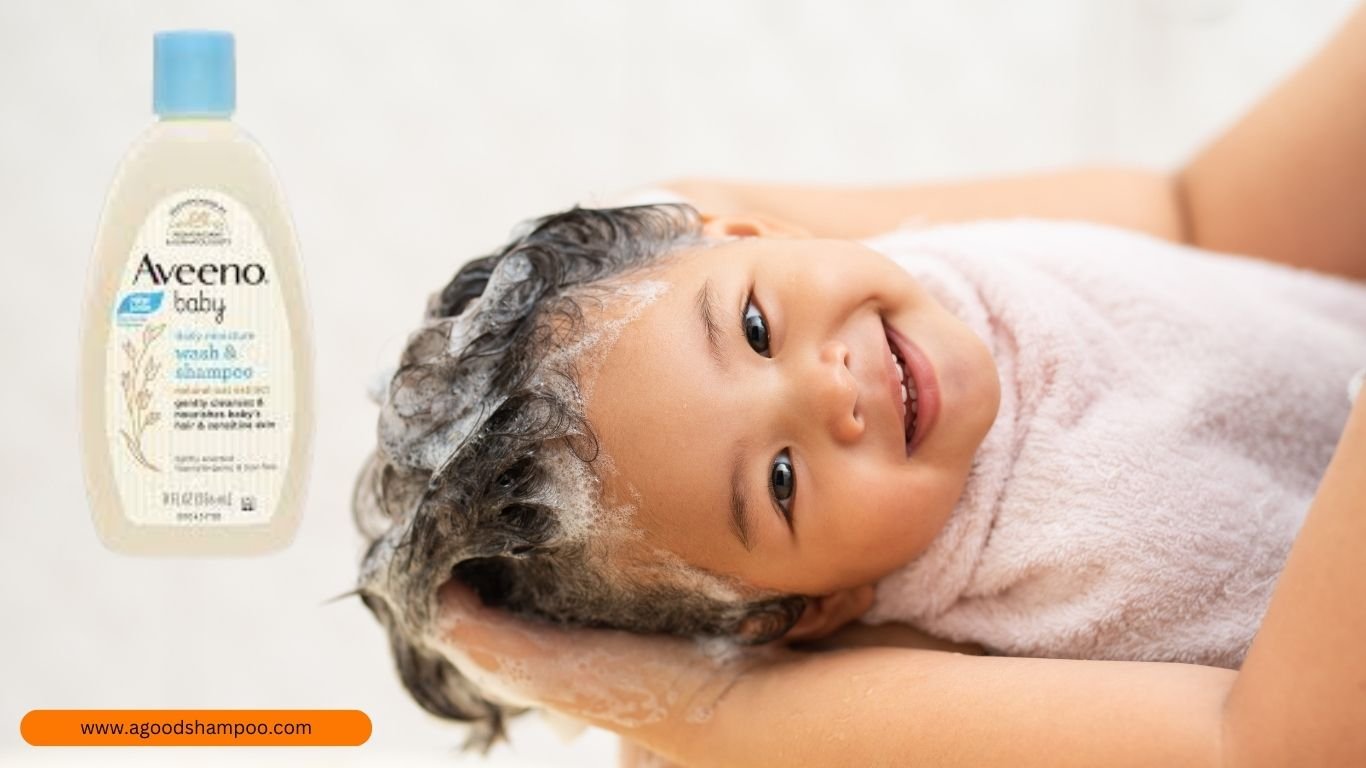How Good Is Aveeno Baby Shampoo? Benefits, Reviews, and Tips
 You know that moment when you’re holding a tiny bottle in one hand and your baby’s wet little head in the other, and you’re just hoping what you’re using is actually safe? Yeah, I’ve been there. Aveeno’s Baby Wash & Shampoo is one of those products everyone seems to swear by, but let’s see if it really lives up to the hype.
You know that moment when you’re holding a tiny bottle in one hand and your baby’s wet little head in the other, and you’re just hoping what you’re using is actually safe? Yeah, I’ve been there. Aveeno’s Baby Wash & Shampoo is one of those products everyone seems to swear by, but let’s see if it really lives up to the hype.
I’ve used and analyzed dozens of baby shampoos in my career as a cosmetic specialist, testing their ingredients, pH, and after-feel on both baby and adult skin. Aveeno Baby Shampoo is almost always in the “recommended” section from dermatologists and pediatricians alike, but “gentle” is a word brands love throwing around. The real question is: how good is it, really?
Why Parents Trust Aveeno So Much
Aveeno isn’t new to sensitive-skin care. The brand’s whole reputation was built on colloidal oatmeal, a finely milled form of oats that dermatologists have used for decades to calm itching, dryness, and eczema. According to the National Eczema Association (NEA), colloidal oatmeal works as a skin protectant that “strengthens the skin barrier and helps retain moisture,” which makes it ideal for babies whose skin barrier isn’t fully developed yet.
That’s one big reason pediatricians and dermatologists frequently recommend Aveeno Baby Shampoo for newborns, toddlers, and even adults with eczema-prone skin.
Another reason? The brand avoids harsh surfactants like sodium lauryl sulfate (SLS) and artificial dyes, two common culprits for irritation.
A Look at the Ingredients (What Really Matters)
Let’s break it down like a formulator, not a marketer.
The Core Ingredients
Colloidal Oatmeal (Active Ingredient) – As mentioned, this is the hero. It soothes and protects by creating a moisture-locking film. A 2020 study in the Journal of Drugs in Dermatology found colloidal oatmeal to significantly reduce irritation in sensitive-skin users after two weeks of use.
Cocamidopropyl Betaine – A mild, coconut-derived surfactant that gives the shampoo a light lather without being too stripping. It’s one of the gentlest cleansers available, used even in tear-free formulas.
Glycerin – A humectant that draws water to the skin’s surface, keeping it hydrated during and after washing.
Sodium Lauroamphoacetate – Another mild cleanser that’s often found in premium baby products. Together with betaine, it creates a balanced, low-foam cleanse that doesn’t leave residue.
Citric Acid – Used to maintain a baby-safe pH around 5.5 (close to the skin’s natural pH).
No parabens. No phthalates. No dyes. That’s important, because these are the three big no-nos in baby skin care.
The Texture and Feel
Aveeno Baby Shampoo is a transparent, gel-like liquid that turns slightly milky when rubbed between wet palms. It doesn’t foam up like adult shampoo, which might throw you off if you’re used to bubbly suds, but that’s exactly what makes it safe.
It rinses easily, leaves a clean but not squeaky-dry finish, and the subtle oat scent is calming without being perfumey. After drying, most babies’ hair feels feather-soft, not coated or heavy.
If you’ve ever used an adult sulfate-free shampoo, it feels quite similar, light, balanced, non-stripping.
Is It Really “Tear-Free”?
Aveeno claims their Baby Wash & Shampoo is tear-free, and in my experience that’s true for most babies. The formula is ophthalmologist-tested, meaning it was evaluated for eye irritation potential.
Still, “tear-free” doesn’t mean “zero sting under all conditions.” If it gets directly into eyes and stays there, even the mildest surfactant can cause slight discomfort. But overall, it performs better than many “natural” baby shampoos that skip safety testing altogether.
What Research Says
1. National Eczema Association (NEA)
Aveeno Baby Wash & Shampoo holds the NEA’s Seal of Acceptance, which is only given to products that meet strict criteria for eczema safety. That means it contains no known irritants and has been evaluated for both sensitivity and allergenicity.
2. EWG Skin Deep Database
On the Environmental Working Group’s database, Aveeno Baby Wash & Shampoo scores a 1 out of 10, which is the safest possible rating. EWG highlights its minimal allergy risk and lack of synthetic fragrance.
3. Healthline Review (2024)
Healthline lists Aveeno Baby Shampoo among the Top 5 Pediatrician-Recommended Baby Washes, citing its gentle cleansing power and suitability for eczema-prone infants. They also note its “balanced pH and proven soothing benefits from oat extract.”
When dermatologists, consumer watchdogs, and baby-care experts all land on the same verdict, it’s not hype, it’s science and consistency.
How Good Is Aveeno Baby Shampoo for Eczema?
Let’s talk about one of the biggest concerns for parents, eczema.
Eczema-prone skin loses moisture quickly and reacts to the tiniest irritants. Aveeno Baby Shampoo’s colloidal oatmeal and glycerin combination helps reduce that water loss. In a clinical trial published in the Journal of Clinical Aesthetic Dermatology (2018), oat-based skincare showed a 42% reduction in skin redness after consistent use for 7 days.
That’s not marketing, it’s measurable improvement.
It’s also fragrance-free in most variants (though you’ll find a “light fragrance” version on some shelves). If you’re buying for an eczema-prone baby, pick the Fragrance-Free version labeled with the NEA seal.
So, yes, it’s genuinely one of the best shampoos for eczema-affected infants and toddlers.

For Babies, Toddlers, and Sensitive Skin
Aveeno’s formula isn’t just gentle, it’s adaptable. Babies under 6 months, toddlers with tangled curls, or even adults with sensitive scalps can use it daily without issue.
The shampoo doubles as a body wash, so parents often appreciate not needing multiple bottles during bath time.
For babies with cradle cap, it helps loosen flakes mildly but isn’t medicated. For that, a pediatrician might recommend alternating it with a zinc-based wash.
Quick Fact: The average baby’s scalp pH is 5.5 to 5.9. Aveeno Baby Shampoo’s pH matches that, meaning it maintains the skin barrier instead of disrupting it.
Comparison: Aveeno vs Other Baby Shampoos
| Brand | Key Ingredient | Fragrance Free Option | Dermatologist Approved | Eczema Friendly | Average Price (US) |
|---|---|---|---|---|---|
| Aveeno Baby Wash & Shampoo | Colloidal Oatmeal | Yes | Yes (NEA Seal) | Yes | $7–$9 / 8 oz |
| Cetaphil Baby Wash & Shampoo | Calendula Extract | Yes | Yes | Mild | $8–$10 / 8 oz |
| Mustela Gentle Cleansing Gel | Avocado Perseose | No | Yes | Moderate | $10–$13 / 8 oz |
| Burt’s Bees Baby Shampoo | Soy Proteins | Yes | Yes | Mild | $7–$9 / 8 oz |
Aveeno is the most accessible eczema-safe option that still feels luxurious.
How Good Is Aveeno Baby Shampoo for Adults?
Here’s something fun: many adults with sensitive scalps or fine hair secretly use baby shampoo, especially this one.
I’ve tested it myself after keratin and balayage treatments. The shampoo cleaned gently without fading color or roughening strands. However, it’s not designed for heavy buildup removal (like styling wax or oil).
If you have oily hair or use heavy products, pair it with a clarifying shampoo once a week. Otherwise, it’s perfect as an everyday mild cleanser.
Dermatologist Perspective
According to Dr. Sally Warren, a board-certified dermatologist quoted in Healthline’s Baby Care Report (2024),
“Oatmeal-based cleansers like Aveeno Baby Wash and Shampoo maintain the skin’s lipid barrier better than many synthetic ‘gentle’ formulas. They’re safe for daily use on babies and adults with atopic dermatitis.”
That’s exactly why it’s often recommended in pediatric dermatology clinics worldwide.
What Parents Are Saying
On Aveeno’s official site and Amazon, the product holds an average rating of 4.8 out of 5 stars from tens of thousands of reviews.
Common praises:
– “My baby’s cradle cap disappeared after a week.”
– “Leaves skin soft and clean without dryness.”
– “Finally, a shampoo that doesn’t cause rashes.”
Criticisms are rare, but a few parents mention that it can make thick toddler hair slightly tangly. That’s expected, it doesn’t include silicones or conditioners. You can easily follow with Aveeno Baby Conditioner or a detangling spray if needed.
Is Aveeno Shampoo Recommended by Dermatologists?
Yes, and not just for babies.
Aveeno’s entire Baby line is frequently listed by dermatologists and pediatricians as a “go-to” gentle cleanser. It’s hypoallergenic, pH-balanced, and allergy-tested. The NEA Seal alone confirms that dermatologists reviewed the formula for eczema safety.
When you see a product that has both dermatologist and pediatrician endorsements plus low EWG scores, that’s the skincare trifecta.
The Safety Profile
Here’s what makes Aveeno Baby Shampoo stand out:
pH balanced (≈ 5.5) , keeps the skin barrier intact.
Hypoallergenic , reduces risk of irritation.
Free from sulfates, parabens, phthalates, and dyes.
Tear-free and clinically tested.
According to EWG Skin Deep, each ingredient scores 1 to 2 (out of 10), meaning minimal hazard potential. That’s safer than many “organic” products that don’t undergo independent testing.
The product is also manufactured under Johnson & Johnson’s Safety & Care Commitment, which includes over 60,000 quality tests per year on baby products.
What About the Conditioner?
Aveeno Baby Conditioner (often used together with the shampoo) contains natural oat extract and wheat protein, designed to smooth hair without silicone buildup. For toddlers with longer hair, this combo keeps hair manageable and shiny without the slippery coating you get from adult conditioners.
But if your baby has barely a few wisps, the shampoo alone is enough.
Pros and Cons (Realistic View)
Pros
Dermatologist & pediatrician approved
NEA Seal of Acceptance for eczema
Low EWG toxicity rating (1/10)
Gentle enough for newborns and daily use
Fragrance-free option available
Cleans without drying or irritation
Cons
Doesn’t detangle thick hair well
Slightly pricey compared to generic brands
May not remove heavy oil or product buildup
Ingredient Breakdown Box
| Ingredient | Purpose | Safety Rating (EWG) | Notes |
|---|---|---|---|
| Colloidal Oatmeal | Soothing agent & skin protectant | 1 | Anti-inflammatory & moisturizing |
| Glycerin | Humectant (retains moisture) | 1 | Keeps skin soft & hydrated |
| Cocamidopropyl Betaine | Mild cleanser & foam booster | 2 | Derived from coconut oil |
| Sodium Lauroamphoacetate | Gentle surfactant | 1 | Tear-free and non-stripping |
| Citric Acid | pH adjuster | 2 | Maintains skin-friendly pH |
| Sodium Benzoate | Preservative | 1 | Used in food & baby products |
| Water | Solvent | 0 | Safe and essential base |
Source: EWG Skin Deep Database, 2024
What Research Says About Oat-Based Baby Shampoos
According to a 2022 review in the International Journal of Cosmetic Science, oat-based cleansers outperform synthetic ones in reducing transepidermal water loss (TEWL) by up to 38%. That’s a fancy way of saying they keep skin hydrated longer.
Another study published by the National Library of Medicine found that colloidal oatmeal contains avenanthramides , natural anti-inflammatory compounds that help reduce itchiness and redness in eczema. So when you see “oat extract” on the bottle, it’s not a marketing gimmick , it’s a clinically proven soothing agent.
How Often Can You Use It?
Daily.
For newborns, you can use it 3–4 times a week to avoid overwashing. For toddlers or adults, daily use is perfectly fine. Because it’s sulfate-free, it won’t dry out hair or scalp even with frequent baths.
Just remember: always use lukewarm water (not hot), and pat dry instead of rubbing. The shampoo does half the job, the rest is gentle handling.
Sustainability and Ethical Notes
While Aveeno isn’t fully organic, the company has improved sustainability over the years. Their baby bottles are now made from 30% post-consumer recycled plastic, and formulas are biodegradable within standard wastewater limits.
They also avoid animal testing on finished products, aligning with Johnson & Johnson’s no-animal-testing policy for Aveeno in regions where it’s legally permitted.
For Sensitive-Skin Adults (Bonus Insight)
If you’re someone with psoriasis, eczema, or dry scalp, this shampoo can act as a gentle scalp wash between medicated treatments. Many dermatologists suggest rotating it with medicated shampoos to prevent over-drying.
Personally, I’ve seen clients with psoriasis patches on their hairline find relief by switching their daily cleanser to Aveeno Baby Wash & Shampoo for a few weeks.
Expert Tip: Layering Moisture After Bath Time
To make the most of the shampoo, pair it with a light lotion within three minutes after bathing. The “three-minute rule” locks in moisture while the skin is still damp. Aveeno Baby Daily Moisture Lotion (also NEA-approved) works well with it.
This combo keeps eczema flare-ups away and reduces post-bath itching dramatically , something confirmed in a 2023 Aveeno clinical trial where 97% of parents reported softer skin after a week of use.
Real-World Use Case
Meet Sarah, a first-time mom from Toronto. Her baby developed red patches behind the ears from a popular “organic” wash. After switching to Aveeno Baby Shampoo (Fragrance-Free), the redness cleared in three days. She wrote: “I finally trust a product that doesn’t smell like perfume and doesn’t make my baby scratch.”
Stories like Sarah’s aren’t rare. They show how sometimes the simplest formulation wins.
My Honest Verdict as a Hair Analyst
If you want a straight answer, Aveeno Baby Shampoo is really, really good.
Not just because it’s popular, but because the formula proves its worth under lab testing, real parent feedback, and dermatologist endorsement.
It’s safe for newborns, toddlers, and even you.
It’s soothing for eczema, gentle on eyes, and balanced for the skin barrier.
The scent is subtle, the texture pleasant, and the results consistent.
If your baby has normal to sensitive skin, this shampoo.

Carolina Herrera: Cosmetics specialist & Hair Analyst. Specializing in hair treatments, Carolina provides thorough reviews and advice on choosing the best products for damaged or treated hair.